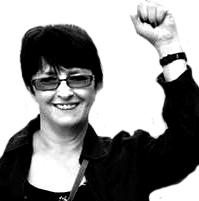I started re-watching (for the fourth? fifth? time – it’s certainly been three times since watching as a child) Star Trek: The Original Series (‘TOS’ to Trekkies) when I was recovering from a knee operation.
I knew that TOS broke new ground in the 1960s. There you have, on the bridge (the starship’s command centre): an alien (well, a half-alien anyway); a Russian (in the middle of the Cold War!); a Japanese man, barely 10 years after the Second World War; a regular hunk who chased the ladies (Kirk, of course); and the coup de grace – Uhura, an African-American female! On the bridge! In a professional capacity!
Famously, Whoopi Goldberg was inspired to go into acting after seeing Nichelle Nichols on screen, and Martin Luther King, no less, encouraged Nichols to stay in the show after she’d expressed a desire to leave, saying: ‘If you leave, they can replace you with a blonde-haired white girl.’
In fact, having a woman on the bridge at all was a coup for the show’s creator, Gene Rodenberry.
The first pilot episode, ‘The Cage’, had a female second-in-command, known as ‘Number One’, but the networks did not like her so she had to go.
The second pilot was better-received and featured the famous cast of Kirk, Spock, Bones, Scotty, Sulu and Uhura (Chekhov didn’t appear until the third season).
In many ways, it was a progressive offering, featuring a multi-racial cast, and male and female characters who worked together as equals. In the years since it went off the air, one criticism TOS has been repeatedly charged with is sexism.
So how feminist is Star Trek? Well there are the costumes. But, as Nichols stated: it was the ’60s, we all wore skirts that short. In fact, miniskirts were, at the time, seen as a symbol of liberation.
Then there’s Kirk and his womanising. I mean, every single episode (almost) he gets to snog a beautiful alien. It’s usually consensual (apart from the famous Uhura/Kirk kiss, which was forced on them by a controlling alien, no doubt to appease southern racists).
At the time, many saw the women of Star Trek as positive role models: they were not housewives and helpmeets, they were professional people working alongside men as equals.
Later re-boots of Star Trek fared rather better. The short skirts were quickly replaced with jumpsuits, and later, jersey and trousers. The opening credits of Star Trek: The Next Generation proclaimed that the mission of the USS Enterprise was to go where ‘no one’ (as opposed to ‘no man’) had gone before.
In one episode, ‘The Neutral Zone’, the Enterprise finds an ancient space capsule with three deep-frozen humans. One was, according to the accompanying records, ‘a home-maker’. Comment from a crew-member, ‘Must be some kind of construction work’.
Women were in positions of authority: female chief medical officer, Beverly Crusher, and counsellor, Deanna Troi, (hmmm, both caring professions) and head of security, Tasha Yar. However, female captains of other ships put in appearances, as do female admirals.
Later still, Star Trek: Voyager included a female engineer, the fierce and tough B’Elanna Torres, and most of all, a female captain, Kathryn Janeway. Plenty of role models there.
The Bechdel test asks: do two named female characters talk to each other about something other than a man? Voyager (1995–2001) had a whopping 87 per cent of episodes passing the test (and every single episode of season 5 passed); Star Trek: Deep Space Nine (1993–1999) was second with 58 per cent; The Next Generation (1987–1994) scored 45 per cent, followed closely behind by the series Enterprise (2001–2005) with 39 per cent. The Original Series (1966–1969) ranked in last place with only 7.5 per cent.
Roddenberry said it perfectly himself: ‘Star Trek was an attempt to say that humanity will reach maturity and wisdom on the day it begins not just to tolerate but take a special delight in differences of life forms.’


